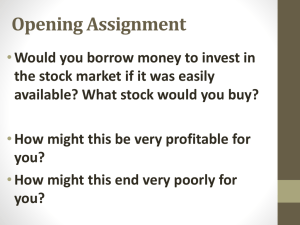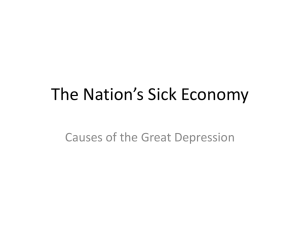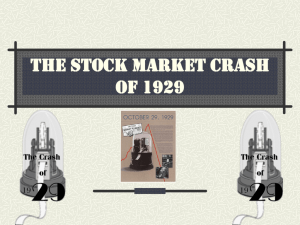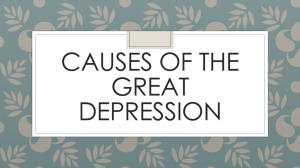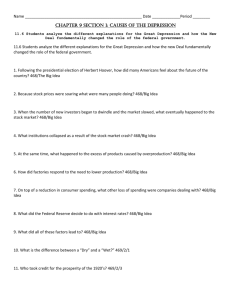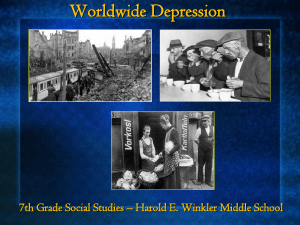Stocks and the Great Depression
advertisement
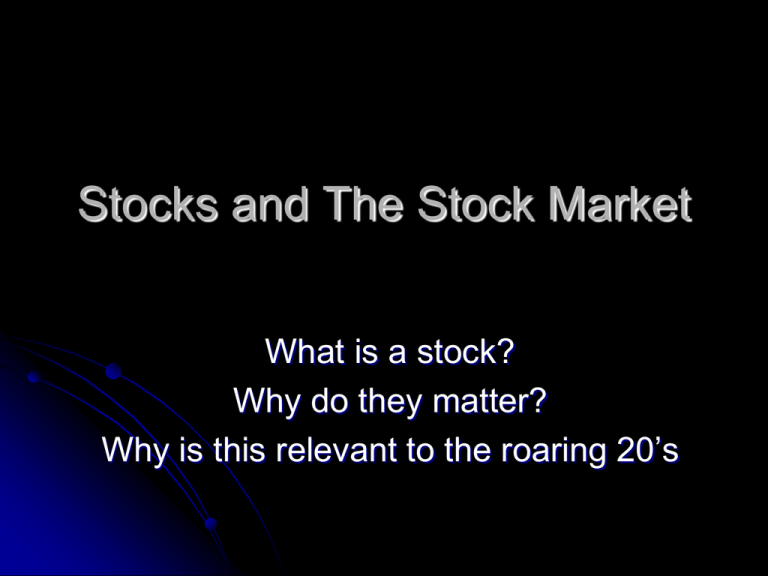
Stocks and The Stock Market What is a stock? Why do they matter? Why is this relevant to the roaring 20’s Homework Watch the business news on CNN or BBC and write a short paragraph (1/2 pg) on what the story was saying and how it relates to today's topics on money, stock market and banks. Or Download and print a current article on money, banks or the stock market and write an explanation/summary of what the article is about and what it is trying to say. The Roaring 20’s The 1920’s were a time of peace and great prosperity. After World War I, the “Roaring Twenties” was fueled by increased industrialization and new technologies, such as the radio and the automobile. Air flight was also becoming widespread, as well. The economy benefited greatly from the new life changing technologies. Skyscrapers and Cars The Stock Market The stock market appears in the news every day. You hear about it any time it reaches a new high or a new low, and you also hear about it daily in statements like "The Dow Jones Industrial Average rose 2 percent today, with advances leading declines by a margin of..." Obviously, stocks and the stock market are important, but you may find that you know very little about them. What is a stock? What is a stock market? Why do we need a stock market? Where does the stock come from to begin with, and why do people want to buy and sell it? What are Shares? You have a restaurant which will probably make at least $75,000 this year you know that from your history with the business. Therefore, you can think of the restaurant as an investment that will pay out something like $75,000 in interest every year. Looking at it that way, someone might be willing to pay $750,000 for the restaurant, as a $75,000 return per year on a $750,000 investment represents a 10-percent rate of return. Someone might even be willing to pay $1,500,000, which represents a 5-percent rate of return, or more if he or she thought that the restaurant's income would grow and increase earnings over time at a rate faster than the rate of inflation. The restaurant's owner, therefore, will set the price accordingly. You might price the restaurant at $1,500,000. What if 10 people come to you and say, "Wow, I would like to buy your restaurant but I don't have $1,500,000." You might want to somehow divide your restaurant into 10 equal pieces and sell each piece for $150,000. In other words, you might sell shares in the restaurant. Then, each person who bought a share would receive one-tenth of the profits at the end of the year, and each person would have one out of 10 votes in any business decisions. A Stock Exchange If I am a private citizen who owns a restaurant, and I am selling my restaurant stock to other private citizens in the community, I might do the whole transaction by word-of-mouth, or by placing an ad in the newspaper. This makes selling the stock easy for me. However, it creates a problem down the line for investors who want to sell their stock in the restaurant. The seller has to go out and find a buyer, which can be hard. A "stock market" solves this problem. Stocks in publicly traded companies are bought and sold at a stock market (also known as a stock exchange). The New York Stock Exchange (NYSE) is an example of such a market. In your neighborhood, you have a "supermarket" that sells food. The reason you go the supermarket is because you can go to one place and buy all of the different types of food that you need in one stop -- it's a lot more convenient than driving around to the butcher, the dairy farmer, the baker, etc. The NYSE is a supermarket for stocks. The NYSE can be thought of as a big room where everyone who wants to buy and sell shares of stocks can go to do their buying and selling. Stock Exchange Lets Visit A Stock Exchange Australian Securities Exchange http://www.asx.com/ Others www.nyse.com www.nasdaq.com www.jsx.co.id Stock Prices Let's say that a new corporation is created and in its IPO it raises $20 million by selling one million shares for $20 a share. The corporation buys its equipment and hires its employees with that money. In the first year, when all the income and expenses are added up, the company makes a profit of $1 million. The board of directors of the company can decide to do a number of things with that $1 million: It could put it in the bank and save it for a rainy day. It could decide to give all of the profits to its shareholders, so it would declare a dividend of $1 per share. It could use the money to buy more equipment and hire more employees to expand the company. It could pick some combination of these three options. Money Questions Discussion What is money Definition Why is it worth what it is? What was the system before money? What are some modern systems that are making money obsolete? What is a Bank? According to Britannica.com, a bank is: an institution that deals in money and its substitutes and provides other financial services. Banks accept deposits and make loans and derive a profit from the difference in the interest rates paid and charged, respectively. Banks are critical to our economy. The primary function of banks is to put their account holders' money to use by lending it out to others who can then use it to buy homes, businesses, send kids to college... When you deposit your money in the bank, your money goes into a big pool of money along with everyone else's, and your account is credited with the amount of your deposit. When you write checks or make withdrawals, that amount is deducted from your account balance. Interest you earn on your balance is also added to your account. How Loans Work Banks create money in the economy by making loans. The amount of money that banks can lend is directly affected by the reserve requirement set by the Federal Reserve. Why does banking work? Banking is all about trust. We trust that the bank will have our money for us when we go to get it. We trust that it will honor the checks we write to pay our bills. The thing that's hard to grasp is the fact that while people are putting money into the bank every day, the bank is lending that same money and more to other people every day. Banks consistently extend more credit than they have cash. That's a little scary; but if you go to the bank and demand your money, you'll get it. However, if everyone goes to the bank at the same time and demands their money (a run on the bank), there might be problem. So What Happened in 1929? The 1929 stock market crash is conventionally said to have occurred on Thursday the 24th and Tuesday the 29th of October. These two dates have been dubbed "Black Thursday" and "Black Tuesday," respectively. On September 3, 1929, the Dow Jones Industrial Average reached a record high of 381.2. At the end of the market day on Thursday, October 24, the market was at 299.5 — a 21 percent decline from the high. On this day the market fell 33 points — a drop of 9 percent — on trading that was approximately three times the normal daily volume for the first nine months of the year. By all accounts, there was a selling panic. By November 13, 1929, the market had fallen to 199. By the time the crash was completed in 1932, following an unprecedented large economic depression, stocks had lost nearly 90 percent of their value. So What? As the Dow Jones Industrial Average soared, many investors quickly snapped up shares. Stocks were seen as extremely safe by most economists, due to the powerful economic boom. Investors soon purchased stock on margin. Margin is the borrowing of stock for the purpose of getting more leverage. For every dollar invested, a margin user would borrow 9 dollars worth of stock. Because of this leverage, if a stock went up 1%, the investor would make 10%! This also works the other way around, exaggerating even minor losses. If a stock drops too much, a margin holder could lose all of their money AND owe their broker money as well. Gamblers Always Lose From 1921 to 1929, the Dow Jones rocketed from 60 to 400! Millionaires were created instantly. Soon stock market trading became America’s favorite pastime as investors jockeyed to make a quick killing. Investors mortgaged their homes, and foolishly invested their life savings in hot stocks, such as Ford and RCA. To the average investor, stocks were a sure thing. Few people actually studied the fundamentals of the companies they invested in. Thousands of fraudulent companies were formed to hoodwink unsavvy investors. Most investors never even thought a crash was possible. To them, the stock market “always went up”. Oops! By 1929, the Fed raised interest rates several times to cool the overheated stock market. By October, the bear market had commenced. On Thursday, October 24 1929, panic selling occurred as investors realized the stock boom had been an over inflated bubble. Margin investors were being decimated as every stock holder tried to liquidate, to no avail. Millionaire margin investors became bankrupt instantly, as the stock market crashed on October 28 th and 29 th. By November of 1929, the Dow sank from 400 to 145. In three days, the New York Stock Exchange erased over 5 billion dollars worth of share values! By the end of the 1929 stock market crash, 16 billion dollars had been shaved off stock capitalization. Where’s My Money!!! To make matters worse, banks had invested their deposits in the stock market. Now that stocks were obliterated, the banks had lost their depositors money! Bank runs started, where bank patrons tried to withdraw their savings all at once. Major banks and brokerage houses became insolvent, adding more fuel to the bear market. The financial system was in shambles. Many bankrupt speculators, who were once aristocracy, commit suicide by jumping out of buildings. Even bank patrons who had not invested in shares became broke as $140 billion of depositor money disappeared and 10,000 banks failed. The Great Depression The stock market crash of 1929 launched the Great Depression. The Depression was the time from October 1929 to the mid 1930’s. Mass poverty occurred then, as many workers lost their jobs and were forced to live in shanty towns. Former millionaire businessmen were reduced to selling apples and pencils on street corners. One third of Americans were below the poverty line in the Great Depression. The Dow Jones finally surpassed its 1929 high, a full 26 years later in 1955. Bank Runs People panic and run to the bank to take out their money making the demand for money higher and the situation even worse. Krismon! The rapid fall in the rupiah, beginning in July-August 1997, soon revealed the underlying weakness of the Indonesian financial sector. Panic selling of rupiah for dollars by Indonesian companies with dollardenominated debt showed that private foreign debt was far higher than previously thought. Worse still, the fact that Bank Indonesia was unaware of the extent of the debt showed its poor capacity to oversee and regulate Indonesia's financial markets. As in Thailand, much of the foreign debt was short-term and due for repayment within twelve months and, with the continuing fall in the rupiah, was increasingly difficult to service. Indonesia High levels of economic growth from 1987–1997 masked a number of structural weaknesses in Indonesia's economy. The legal system was very weak, and there was and is no effective way to enforce contracts, collect debts, or sue for bankruptcy. Banking practices were very unsophisticated, with collateral-based lending the norm and widespread violation of prudential regulations, including limits on connected lending. Non-tariff barriers, rent-seeking by state-owned enterprises, domestic subsidies, barriers to domestic trade, and export restrictions all created economic distortions. Democracy at Last Your Money Based on what you have read about banks, money and stock markets: What would you do if you had 100,000 dollars to spend? What are some other options besides these three for storing money? What do you think ended the Great Depression? HW: Essay The stock market in the 20s was a time of great wealth and great disaster. Explain how the consumer culture of the 20s led to the overuse of the stock market and how this inevitably led to the Great Depression.
